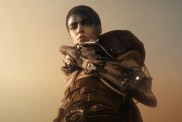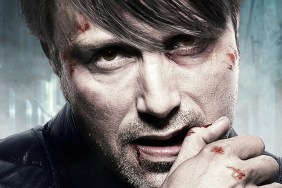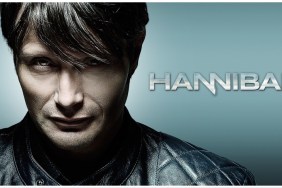
Hannibal Lecter could never be boring. He is an amalgam of evils, many monsters at once, a mythic mindfucker. He was born from a brief exchange between Thomas Harris and a mysterious prison inmate, a doctor who selflessly served the poor and who used his surgeons skill to cut his victim into pieces small enough to fit into a little box. He has become much more than that since Harris first met the germ of Lecter.
Harris wrote, Like Giotto, Dr. Lecter has frescoed the walls of his mind. In season 2 of NBCs Hannibal, Lecter speaks to Will Graham of his memory palace, which is vast, even by medieval standards. His mind is infinite, he could be interesting alone doing nothing at all but, like a fine wine paired with the perfect meal, he reaches his full potential when matched with the right characters.
In Hannibals season premiere Antipasto, we find him in Europe with Bedelia Du Maurier, his ex-psychiatrist, an old plaything; his surrogate Will Graham. The episode immerses us in Bedelias dark dream, and the dream is vivid: vibrant as an illuminated manuscript, and rendered with an Italian Renaissance color palette of old gold, bright blue, and vermilion. We can almost taste the champagne bursting from a broken bottle or feel the quilted leather of Hannibals jacket.
But the episode chills as much as it intoxicates. Is Bedelia under Hannibals spell, or does she match his wickedness? Is her dream a nightmare or a fairytale? Bedelia herself does not know the answer, and recurring images of water and blood haunt Antipasto. She and Hannibal are either stained by blood or cleansing themselves of it: Bedelia drenched in it after killing her patient and washing her hands afterward; her bath that she nearly drowns in; a dead rabbit dripping blood from its muzzle in an Italian shop; Hannibals shower after potentially killing most of the shows cast; and one last condemning splash of Anthony Dimmonds blood on Bedelias cheek, as Hannibal cracks his skull with the bust of Aristotle.
While Bedelia drowns, Hannibal breathes easy. He has, after all, killed hardly anyone during his time in Florence and found a peace there. His only victims are Dr Fell, the professor whose identity he assumes, and Dimmond, the man who knows his secret. Inspiration strikes Hannibal thanks to Leonardo da Vincis Vitruvian Man, an image of symmetry in the body and its harmony with the natural world, which he turns into an origami heart on a scenic train ride. Hannibal thinks also of Dantes first sonnet in La Vita Nuova (The New Life), recited at the episodes beginning in his perfect Italian, in which Dante offers his love a burning heart to consume. And so Dimmonds body, transformed into the shape of a heart at the episodes end, becomes an offering to Bedelia, to Florence, to the universe; a symbol of his peace and the start of his new life.

The premieres second most striking image: Cornelis Galle Is Lucifer superimposed onto the face of Lecter as he lectures on Dante. In the engraving, Lucifer consumes the damned. Next to his motorcycle hunt for Dr. Fell in Paris, this is Antipasto at its most thrilling Hannibal Lecter finally unmasked, his true face revealed to be the face of Lucifer. Mads Mikkelsen stated early on that he wanted to play Hannibal not as Anthony Hopkins or Brian Cox had, but as Satan himself. You really are the devil, Abel Gideon tells him, and Hannibals own words echo from last seasons traumatic finale: Now that you know me, see me.
But Hannibal Lecters DNA is even more complex than that. His ancestry can be traced to mad scientist Victor Frankenstein, Dr Jekyll and Mr Hyde, Bluebeard, even the sideshow freak on display in his plexiglass cell. There are notes of the hedonistic, near-omniscient Sherlock Holmes, and like Dracula, he feeds off peoples flesh and their pain. Joseph Campbell once explained: In the Greek, the demon is that unconscious impulse that is the dynamic of your life and which comes to you in vision and in dream, but in the Christian interpretation, it is a devil all that a devil is is a repressed demon: one who has not been recognized, one that has not been given its dues, who has not been allowed to play into your life and so becomes a violent threat. He could have been talking about Hannibal.
At his most endearing, Dr. Lecter is one of the Greek Furies, those spirits of vengeance who drive their victims mad, and when he eats the rude, he is the Old Testament God striking down the wicked. Despite such an impressive lineage, maybe the most seductive thing about him is that hes your friend who wants you to embrace all that you are: both the light and the dark, The Lamb and The Tyger and maybe, if youre really lucky, the Great Red Dragon. He manufactures chaos, but he is also an agent of transformation, and he brings out what is, to his mind, the best in you.
And he looks wonderful in a black leather jacket. It fits him better than his person suit ever did.
—
Priscilla Page is a writer, book hoarder, and dog companion who lives in Los Angeles. She spends her spare time single-handedly taking down a shadowy crime syndicate. Follow Priscilla on Twitter @BBW_BFF.









